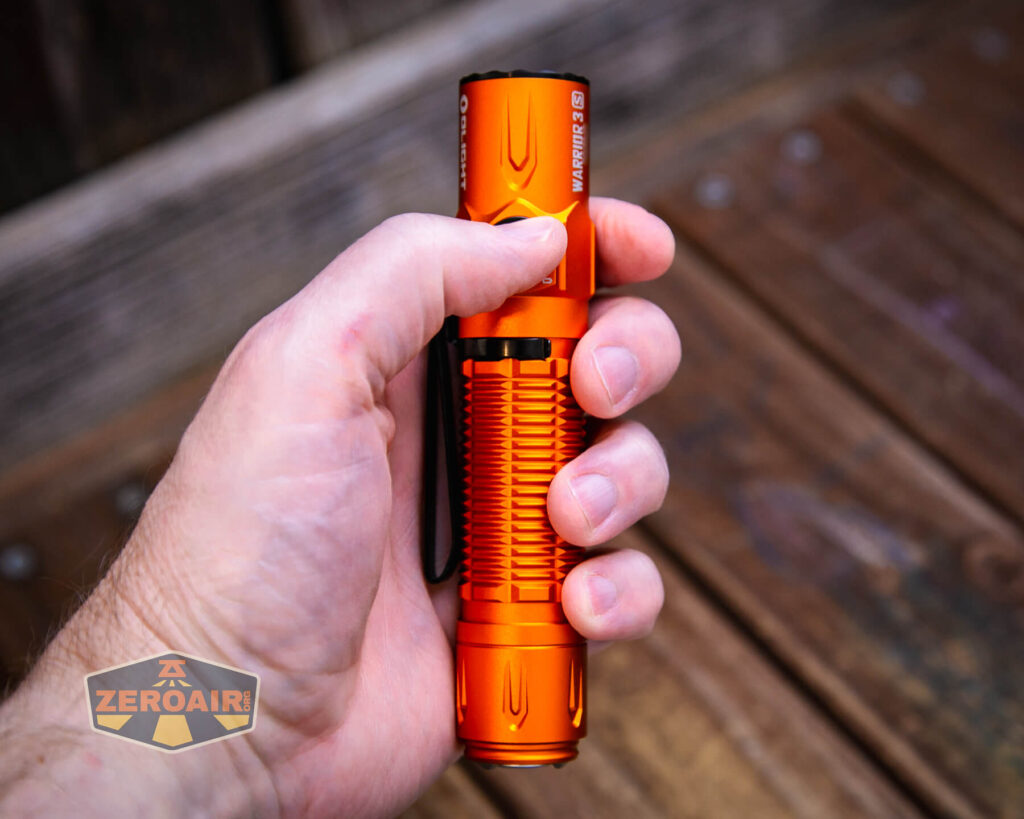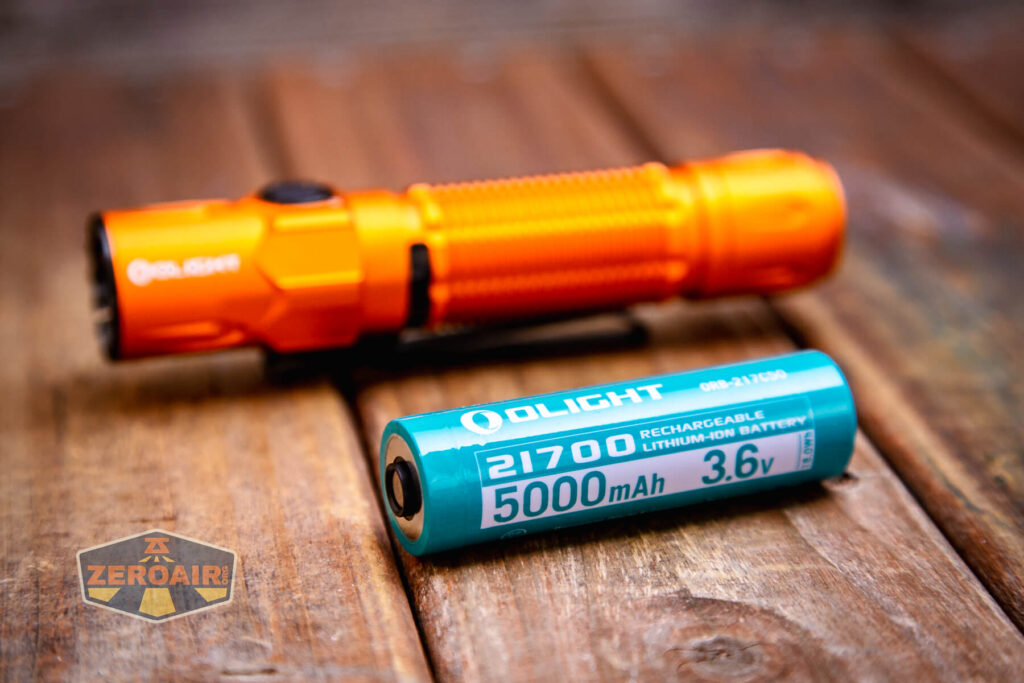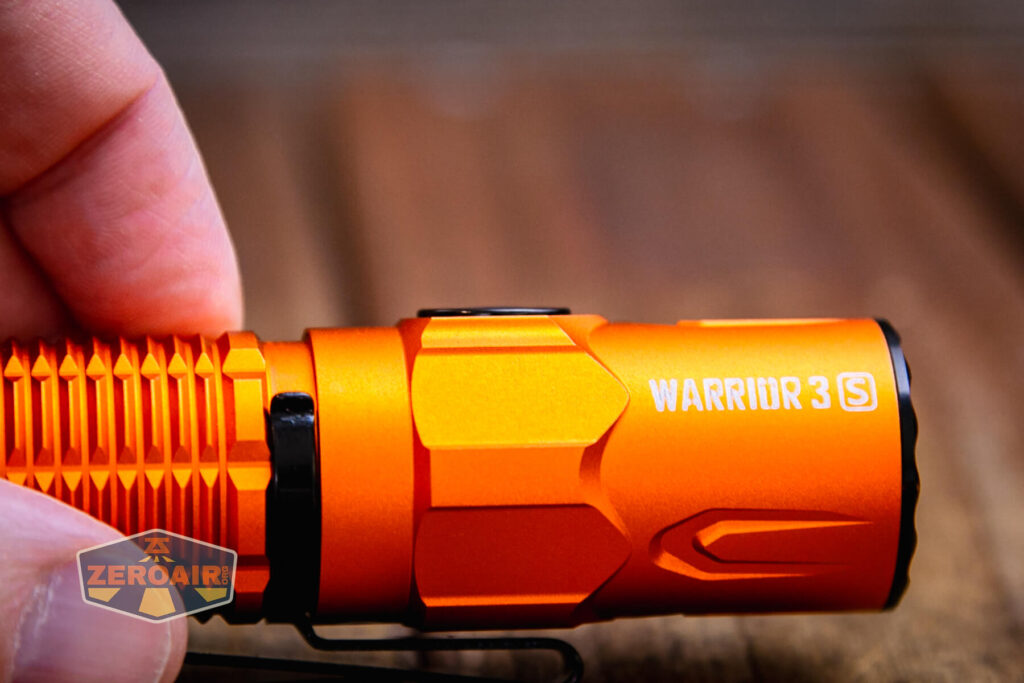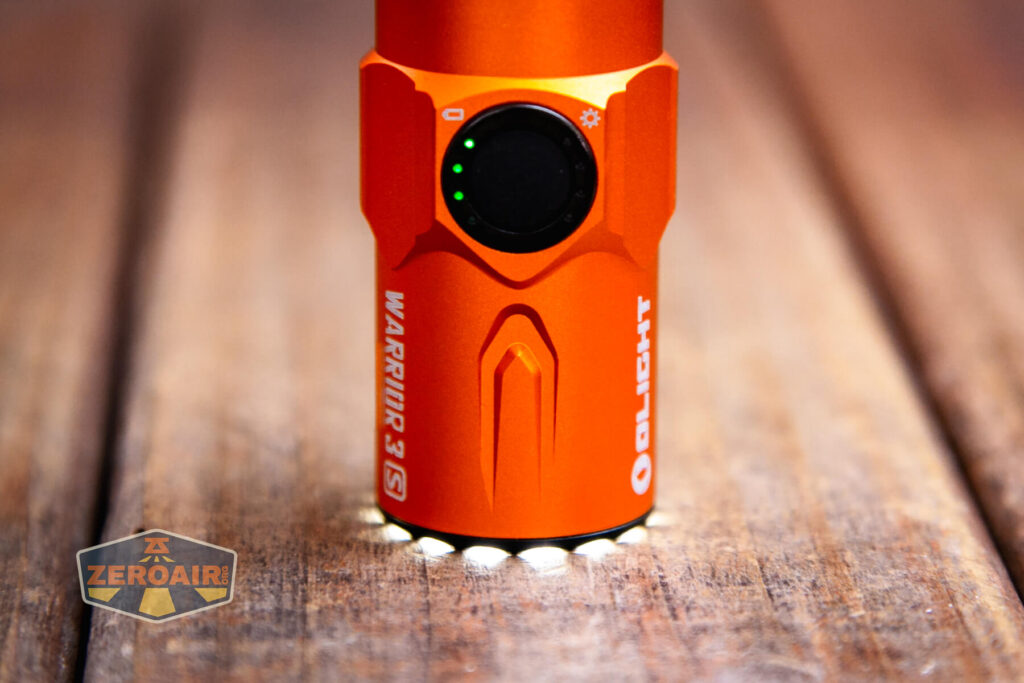Olight Warrior 3S Orange Flashlight Review
The Olight Warrior 3S Orange flashlight is now available! This light uses an included 21700 cell and has dual switches! Read on!
Official Specs and Features
Here’s a referral link to the Olight Warrior 3S Orange flashlight product page.
Versions
A few body colors are available. Among those are orange (seen here), black, green, and apparently a “Five Elements” limited edition set made of titanium and copper. This orange (and black and green) are aluminum.
They all appear to have the same emitter.
Price
The orange iteration of the Olight Warrior 3S flashlight has an MSRP of $119.9,9 but is offered as Olight often does, with a discounted introductory price. In this case, that’s $89.99 for the Olight Warrior 3S Orange flashlight.
Short Review
I’ve actually reviewed the black body version of this light before – here’s the review of the Olight Warrior 3S flashlight. I don’t think anything (or much?) has changed from that version to this version, except that this iteration is orange. Obviously, orange is extremely better.
In general, though, about the Warrior 3S: I do love the light. The beam profile is fantastic, the output is great, and feature-wise, it’s just a great option.
Long Review
The Big Table
| Olight Warrior 3S Flashlight (Orange body) | |
|---|---|
| Emitter: | Luminus SFT70 (Cool White) |
| Price in USD at publication time: | $89.99 |
| Cell: | 1×21700 |
| Runtime Graphs | |
| LVP? | Yes |
| Switch Type: | Both |
| Quiescent Current (mA): | ? |
| On-Board Charging? | Yes |
| Charge Port Type: | Proprietary Magnetic |
| Charge Graph | |
| Power off Charge Port | |
| Claimed Lumens (lm) | 2300 |
| Measured Lumens (at 30s) | 2068 (89.9% of claim)^ |
| Candela per Lumen | 13.3 |
| Claimed Throw (m) | 300 |
| Candela (Calculated) in cd (at 30s) | 1004lux @ 4.88m = 23910cd |
| Throw (Calculated) (m) | 309.3 (103.1% of claim)^ |
| Claimed CCT | – |
| Measured CCT Range (K) | 5900-6800 Kelvin |
| Item provided for review by: | Olight |
| All my Olight reviews! | |
^ Measurement disclaimer: Testing flashlights is my hobby. I use hobbyist-level equipment for testing, including some I made myself. Try not to get buried in the details of manufacturer specifications versus measurements recorded here; A certain amount of difference (say, 10 or 15%) is perfectly reasonable.
What’s Included
- Olight Warrior 3S Orange flashlight
- Olight 5000mAh Proprietary 21700
- Nylon Carry Pouch
- Charge cable (USB to proprietary magnetic)
- Manual
Package and Manual
Build Quality and Disassembly
As I said, there’s not much updated on this Warrior 3S from the previous Warrior 3S (or the M2R Pro or Warrior 3). I really like all those previous models quite a bit, and this one is orange, so … obviously, it’s the most superior one.
We still have the fairly standard tailcap setup here from Olight. The threads are so smooth, too. Just over 6 full turns are required for tightening the tailcap – quite long threads.
Both the head and tail have springs – that button on the tailcap is springy. Also, note the bit on the head end that makes the proprietary cell work. The spring is for positive contact, and the ring around it is for negative contact on the cell.
Size and Comps
Weight (g / oz) 176g/6.21oz
Length (mm / in) 139/5.47
Body Diameter (mm / in) 29.5/1.16
If the flashlight will headstand, I’ll show it here (usually the third photo). If the flashlight will tailstand, I’ll also show that (usually in the fourth photo).
Here’s the test light with the venerable Convoy S2+. Mine’s a custom “baked” edition Nichia 219b triple. A very nice 18650 light.
Also above is the light beside my custom engraved TorchLAB BOSS 35, an 18350 light. I reviewed the aluminum version of that light in both 35 and 70 formats.
Retention and Carry
First off I’ll mention the pocket clip. Not only does it fit on the head or tail end of the light, it’s also a “two-way” friction fit clip. The clip is long and well suited for this light.
Clip hug! There’s a place where you can attach the clip on the tail end, too.
There’s a nylon pouch too, which is quite nice. Both ends have a drainage hole but do not offer access to the light itself. The pouch opens not with velcro, but with a little quick release.
Still, probably the highest-quality nylon pouch I’ve seen with a light.
The magnet in the tailcap that’s used for connecting the charger is not really suited for holding the light, but if you’re careful, it will say hanging in the way seen below.
The Olight Warrior 3S flashlight does not ship with a lanyard.
Power and Runtime
The Olight Warrior 3S Orange flashlight is powered by a proprietary 21700 cell. It’s proprietary in that both positive and negative terminals are exposed on the positive end of the cell. It will not be charged in a bay-type charger. Also, traditional 21700 cells will not work in the light, and can’t be charged by the light.
The cell goes into the light in the “normal” way – positive end toward the head.
Here are three runtimes. The three highest outputs. Turbo steps down completely in under 2 minutes, but it takes over 1 minute to begin the dramatic decline. Once it’s stepped down, the output is exceptionally stable at around 600 lumens. A final stepdown to around 250 lumens happens at ~150 minutes. These are timed step-downs, per the manual.
The output on High looks about like the output on Turbo, aside from the first blip of actual Turbo output. The duration overall is about the same.
Low voltage protection is present, and the light shuts off after a warning in the e-switch, at around 3V. This is great.
Charging
As mentioned, the Olight Warrior 3S Orange flashlight has onboard charging via a USB to a magnetic connector.
The name of this one is the MCC 1A/1.5A/2A, noteworthy since Olight makes a number of these charge bases.
The light will stand while on the charge base thanks to the tripod contact points seen below.
Here’s a charge test – the charge rate goes up to over 2A and takes around 4 hours. The charging indicator goes from red (charging) to green (charging “completed”) at approximately 250 minutes, but does seem to continue charging after switching to green. The charge rate is low (around 0.07A but does not seem to trickle off. The cell does not seem to be overcharged, though.
Modes and Currents
| Mode | Mode Claimed Output (lm) | Claimed Runtime | Measured Lumens | Tailcap Amps |
|---|---|---|---|---|
| Turbo | 2300/800/250 | 2.5m/160m/39m | 2069 | 6.42 |
| High | 800/250 | 166m/39m | 709 | 1.34 |
| Stepdown level | – | – | 250 | 0.42 |
| Med | 200 | 13h | 175 | 0.29 |
| Low | 15 | 130h | 14.9 | 0.02 |
| Moon | 1 | 55d | 0.80 | low |
Pulse Width Modulation
There’s no PWM on any mode.
Here you can see a “baseline” – a chart with almost no light hitting the sensor. Then there’s the Ultrafire WF-602C flashlight, which has some of the worst PWM I’ve seen. It’s so bad that I used a post about it to explain PWM! Here are multiple timescales (10ms, 5ms, 2ms, 1ms, 0.5ms, 0.2ms) to make comparing this “worst” PWM light to the test light easier. That post also explains why I didn’t test the WF-602C at the usual 50us scale.
User Interface and Operation
There are two switches on the Olight Warrior 3S flashlight. First is the metal tail switch which also is used in charging.
I love the two-stage switch on these 21700 lights. It’s less perfect on the smaller 18650 versions BUT that doesn’t stop me from wanting it in an 18350 format. I really love it.
Next is the side e-switch.
This e-switch on the side of the head is flat and pleasantly large. On both sides of the switch are four green LEDs. The right side indicates the cell charge level (below seen as four green spots in every photo). The four on the left indicate which output level is selected.
Here’s a user interface table!
| State | Action | Result |
|---|---|---|
| Off | Click Side Switch | On (Mode Memory; Moonlight can be memorized but Turbo can not) |
| Off | Hold Side Switch | Moon |
| Off | Double Click Side Switch | Turbo |
| Any | Triple Click Side Switch | Strobe |
| On | Click Side Switch | Off |
| On | Hold Side Switch | Mode Advance (L>M>H) (Moon and Turbo are excluded from the cycle) |
| Turbo | Double Click Side Switch | Return to previous mode (High and Medium both return to Medium) |
| Off | Long Hold Side Switch | Lockout (Technically “Moon then lockout”) |
| Lockout | Click Side Switch | Indicator around Side Switch blink red for 2s to indicate lockout |
| Lockout | Hold Side Switch | Unlock to Moonlight |
| Any | Hold (“half-press”) Tail Switch | Medium (in Config 1, default) Turbo (in Config 2) |
| Any | Click Tail Switch | Turbo (in Config 1) Strobe (in Config 2) |
| Off | Hold Tail Switch, Click Side Switch | Switch between Config 1 and 2 (there is no confirmation. You can differentiate by actuating the tail switch and observing the mode.) |
| Within 5 seconds after proximity sensor stepdown | Double click Side Switch | Proximity sensor is disabled until the light is turned off. |
One huge upgrade that Olight has been making (and is included in the Warrior 3S) is that the proximity sensor can be disabled! Here’s how. With the light on, cause the proximity sensor to activate. Within 5 seconds from the light stepping down, double click. The sensor is now disabled for this session. Double clicking will of course enter Turbo output, but you can cycle the modes and the proximity sensor will still be disabled. Turning the light off resets the proximity sensor!
LED and Beam
Olight carefully doesn’t mention what emitter is used in the Warrior 3S flashlight. Whatever is used has no dome, so throw should be good. I read from other sources that this is a Luminus SFT70 emitter. Either way, it is cool white.
Also, the Olight Warrior 3S Orange flashlight uses a TIR, which further accentuates the already-throwy emitter profile.
LED Color Report (CRI and CCT)
Here’s a CRI report for all modes, after an emitter warmup. What can we say about this? No surprise that turbo turns cooler in the Kelvin range. Another thing we can say is that it’s decidedly low CRI (around 70). And the third important point is “how are the reds” – the very negative R9 tells us this. And a final point is the Duv being positive (and really a “not small” positive number) indicates there’s enough green here that you’ll probably notice.
Beamshots
These beamshots always have the following settings: f8, ISO100, 0.3s shutter, and manual 5000K exposure. These photos are taken at floor level, and the beam hits the ceiling around 9 feet away.
Tint vs BLF-348 (KillzoneFlashlights.com 219b version) (affiliate link)
I keep the test flashlight on the left and the BLF-348 reference flashlight on the right.
I compare everything to the KillzoneFlashlights.com 219b BLF-348 because it’s inexpensive and has the best tint!
Conclusion
What I like
- Great build quality
- Fantastic beam profile
- Orange body!
- Great dual switch interface
- Proximity sensor can be disabled
- The new “Fuel Gauge” trickling down from bigger lights to this one – a big positive
- Flat e-switch. This sounds minor, but it’s very pleasant.
What I don’t like
- Proprietary charging
- Customized 21700
- Cool white emitter
Notes
- This content originally appeared at zeroair.org. Please visit there for the best experience!
- For flashlight-related patches, stickers, and gear, head over to PhotonPhreaks.com!
- Please use my amazon.com referral link to help support zeroair.org!
- Please support me on Patreon! I deeply appreciate your support!









































































Of course I understand the huge amount of commercials. You need many to make some money.
I visited your site many times. Your reviews are very informative.
But those commercials??? Welll…